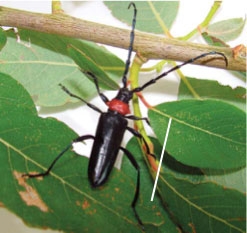The red necked longicorn (Aromia bungii) is a major pest of peach, plum and cherry trees in China, Mongolia and Korea.
It also infests apricots, poplars and neem trees (Azadirachta indica).
It recently established in Japan and is threatening the beautiful old cherry blossom trees which are a significant part of the local culture and of high importance for tourism.
It has also entered Europe—it was found in a home garden plum tree in Bavaria in southern Germany.
Red necked longicorn has been intercepted by quarantine in the UK and USA.
Identification
The adults are unmistakable in appearance, with shiny black body about 25 to 30 mm in length and a bright red collar. Males have longer antennae than females.
Life cycle and behaviour
Eggs are laid in cavities made in the bark close to ground level in mid summer.
Larvae initially feed in the sapwood but then burrow into the heartwood and make extensive galleries.
The life cycle takes two to three years. It is common to find multiple larvae and galleries in a single tree.
Adults emerge in spring. They feed on vegetation in the tree canopy, then mate, lay eggs for several weeks and die.
Pest status
Red necked longicorns are tree killers.
Multiple larvae burrow into the trunks of trees just above ground level leaving tell tale piles of sawdust.
Tree vigour and crop yield is reduced and the trees must be removed or die prematurely. They are a major problem for peach and cherry growers in China.
Control of Red necked longicorn (continued next month)
See this issue in Tree Fruit Oct 2017




















